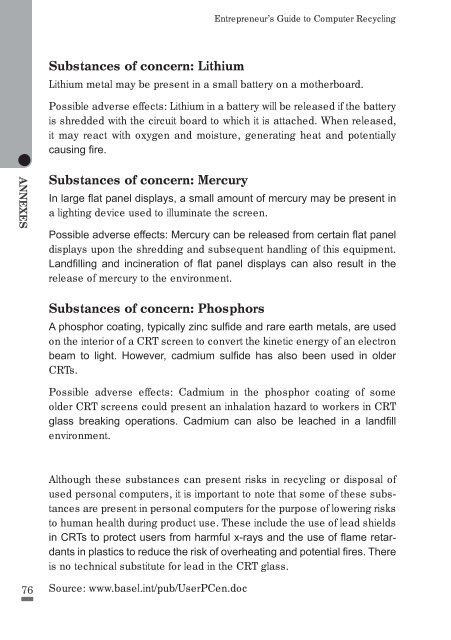The Entrepreneur's Guide to Computer Recycling - e-Waste. This ...
The Entrepreneur's Guide to Computer Recycling - e-Waste. This ...
The Entrepreneur's Guide to Computer Recycling - e-Waste. This ...
Create successful ePaper yourself
Turn your PDF publications into a flip-book with our unique Google optimized e-Paper software.
Entrepreneur’s <strong>Guide</strong> <strong>to</strong> <strong>Computer</strong> <strong>Recycling</strong>Substances of concern: LithiumLithium metal may be present in a small battery on a motherboard.Possible adverse effects: Lithium in a battery will be released if the batteryis shredded with the circuit board <strong>to</strong> which it is attached. When released,it may react with oxygen and moisture, generating heat and potentiallycausing fire.ANNEXESSubstances of concern: MercuryIn large flat panel displays, a small amount of mercury may be present ina lighting device used <strong>to</strong> illuminate the screen.Possible adverse effects: Mercury can be released from certain flat paneldisplays upon the shredding and subsequent handling of this equipment.Landfilling and incineration of flat panel displays can also result in therelease of mercury <strong>to</strong> the environment.Substances of concern: PhosphorsA phosphor coating, typically zinc sulfide and rare earth metals, are usedon the interior of a CRT screen <strong>to</strong> convert the kinetic energy of an electronbeam <strong>to</strong> light. However, cadmium sulfide has also been used in olderCRTs.Possible adverse effects: Cadmium in the phosphor coating of someolder CRT screens could present an inhalation hazard <strong>to</strong> workers in CRTglass breaking operations. Cadmium can also be leached in a landfillenvironment.Although these substances can present risks in recycling or disposal ofused personal computers, it is important <strong>to</strong> note that some of these substancesare present in personal computers for the purpose of lowering risks<strong>to</strong> human health during product use. <strong>The</strong>se include the use of lead shieldsin CRTs <strong>to</strong> protect users from harmful x-rays and the use of flame retardantsin plastics <strong>to</strong> reduce the risk of overheating and potential fires. <strong>The</strong>reis no technical substitute for lead in the CRT glass.76Source: www.basel.int/pub/UserPCen.doc
















